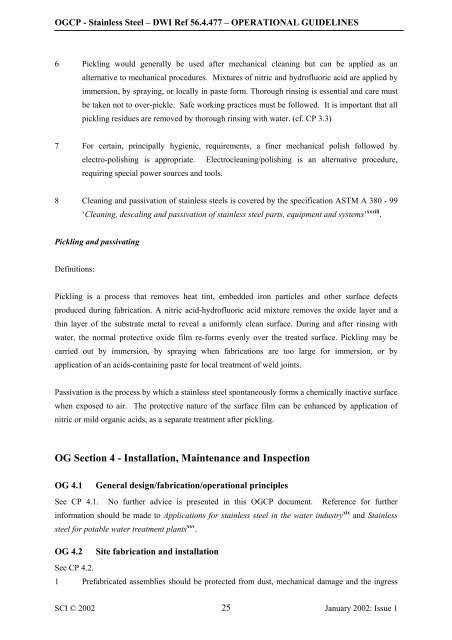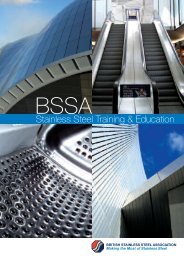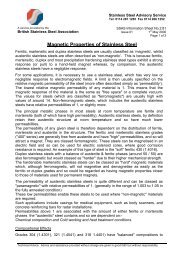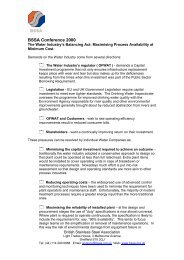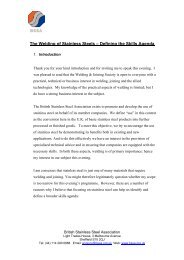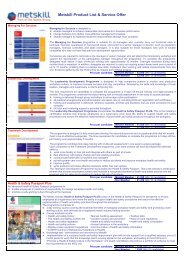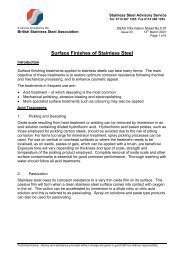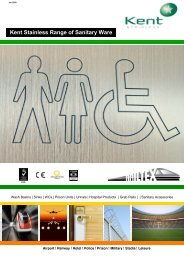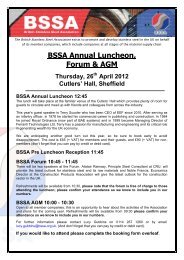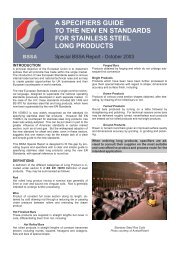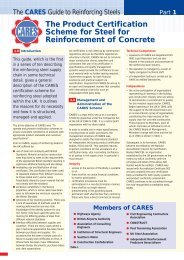Operational guidelines and code of practice for stainless steel
Operational guidelines and code of practice for stainless steel
Operational guidelines and code of practice for stainless steel
Create successful ePaper yourself
Turn your PDF publications into a flip-book with our unique Google optimized e-Paper software.
OGCP - Stainless Steel – DWI Ref 56.4.477 – OPERATIONAL GUIDELINES<br />
6 Pickling would generally be used after mechanical cleaning but can be applied as an<br />
alternative to mechanical procedures. Mixtures <strong>of</strong> nitric <strong>and</strong> hydr<strong>of</strong>luoric acid are applied by<br />
immersion, by spraying, or locally in paste <strong>for</strong>m. Thorough rinsing is essential <strong>and</strong> care must<br />
be taken not to over-pickle. Safe working <strong>practice</strong>s must be followed. It is important that all<br />
pickling residues are removed by thorough rinsing with water. (cf. CP 3.3)<br />
7 For certain, principally hygienic, requirements, a finer mechanical polish followed by<br />
electro-polishing is appropriate. Electrocleaning/polishing is an alternative procedure,<br />
requiring special power sources <strong>and</strong> tools.<br />
8 Cleaning <strong>and</strong> passivation <strong>of</strong> <strong>stainless</strong> <strong>steel</strong>s is covered by the specification ASTM A 380 - 99<br />
‘Cleaning, descaling <strong>and</strong> passivation <strong>of</strong> <strong>stainless</strong> <strong>steel</strong> parts, equipment <strong>and</strong> systems’ xxxiii .<br />
Pickling <strong>and</strong> passivating<br />
Definitions:<br />
Pickling is a process that removes heat tint, embedded iron particles <strong>and</strong> other surface defects<br />
produced during fabrication. A nitric acid-hydr<strong>of</strong>luoric acid mixture removes the oxide layer <strong>and</strong> a<br />
thin layer <strong>of</strong> the substrate metal to reveal a uni<strong>for</strong>mly clean surface. During <strong>and</strong> after rinsing with<br />
water, the normal protective oxide film re-<strong>for</strong>ms evenly over the treated surface. Pickling may be<br />
carried out by immersion, by spraying when fabrications are too large <strong>for</strong> immersion, or by<br />
application <strong>of</strong> an acids-containing paste <strong>for</strong> local treatment <strong>of</strong> weld joints.<br />
Passivation is the process by which a <strong>stainless</strong> <strong>steel</strong> spontaneously <strong>for</strong>ms a chemically inactive surface<br />
when exposed to air. The protective nature <strong>of</strong> the surface film can be enhanced by application <strong>of</strong><br />
nitric or mild organic acids, as a separate treatment after pickling.<br />
OG Section 4 - Installation, Maintenance <strong>and</strong> Inspection<br />
OG 4.1 General design/fabrication/operational principles<br />
See CP 4.1. No further advice is presented in this OGCP document. Reference <strong>for</strong> further<br />
in<strong>for</strong>mation should be made to Applications <strong>for</strong> <strong>stainless</strong> <strong>steel</strong> in the water industry xix <strong>and</strong> Stainless<br />
<strong>steel</strong> <strong>for</strong> potable water treatment plants xxv .<br />
OG 4.2 Site fabrication <strong>and</strong> installation<br />
See CP 4.2.<br />
1 Prefabricated assemblies should be protected from dust, mechanical damage <strong>and</strong> the ingress<br />
SCI © 2002 25<br />
January 2002: Issue 1


